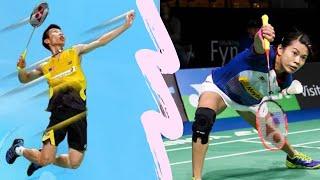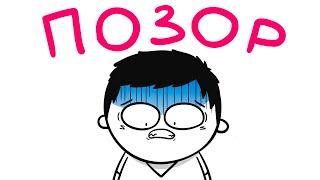
Badminton ATTACK vs DEFFENCE?
SUBSCRIBE - https://www.youtube.com/channel/UCmHSBg8UHBsNTrF4A1I-u8A?sub_confirmation=1
Defending against the smash in badminton
DRIVES
Drives are an excellent counter-attacking shot, especially against flat smashes. The main aim of a drive is to get the shuttlecock beyond the front player, so that he cannot intercept it.
When the front player stands too far forward (say, on the short service line), drives are the shot of choice: it will be relatively easy to get the shuttlecock past him in this position.
If this happens, then you must still be prepared to fight for the attack. The rear player may be able to play a counter-drive, or a shot to the net. Nevertheless you have improved your situation greatly; and in many cases, your drive alone will be enough to gain the attack outright.
The front player will try to intercept your drive first, however. If he succeeds, you’re probably in trouble.
LIFTS
Lifts allow the opponents to continue smashing, but they are often necessary because the attack is too strong to be countered immediately. A poor counter-attacking shot will lose you the rally.
For example: under the pressure of a fierce smash, you try playing a block to the net, in order to regain the attack. Unfortunately you fail to control the shot, and your block is too loose. The front player kills it.
Even at the world-class level, you will see many lifts. This is because the attack is ferocious, and the defenders are biding their time, waiting for a better opportunity to counter-attack: waiting for a smash that is just a little slower, less steep, or less well-placed.
So whenever you are unable to play a good counter-attacking shot, play a lift, and look for the next opportunity to counter-attack.
PUSHES
A push is much the same as a block, but with extra pace. Unlike a block, however, you’re aiming to get the shuttlecock just past the front player, to fall in the midcourt.
As with drives, pushes can be more effective when the front player has moved farther forwards than usual. Because pushes are slower than drives, however, it’s more difficult to sneak one past the front player; but if you succeed, then the back player will probably be forced to play a lift.
Successful pushes are among the best counter-attacking shots, but you need good judgement to spot the right time to use them. They are usually more risky than drives, but also more rewarding.
Defending against drop shots
Your choice of reply depends heavily upon how early you can take the shuttlecock. Most of the time you will be reaching it well below net height, and here your only viable option is a lift.
If you are able to reach it earlier, however, you should consider counter-attacking shots. The best shot is a net kill, but this is only possible when your opponent has played a very weak shot. Nevertheless this does happen, even at the highest levels of play; and you must make the effort to take advantage of your opponent’s mistake!
If you are taking it slightly below net height, then net shots, drives, and pushes are good options (again, use the push to get the shuttlecock past the front player, but in front of the rear player).
Be careful of playing a drive if it will travel to the back player’s forehand!
BLOCKS TO THE NET
A block to the net is a direct challenge to the front player. Blocks are especially effective when the front player stands farther back from the net, in a position to intercept drives.
It’s essential that your blocks are not too loopy and slow; they need a bit of pace. Playing a slow block gives the front player too much time, and he will meet the shuttlecock almost as it crosses the tape (then you lose).
If you play a block, follow it in to the net. This is standard even when you have blocked cross-court, because you can start moving before your partner realises what shot you played (and your partner will also be well placed to become the rearcourt attacker). The only common exception is for the man in mixed doubles, who should usually leave his woman partner to take the net position.
Following the block means you can challenge the front attacker for control of the net, pressuring him to play a lift. If you just hang back and watch your shot instead, he can play a net shot — even a loose one — because no-one is covering it.
Defending against the smash in badminton
DRIVES
Drives are an excellent counter-attacking shot, especially against flat smashes. The main aim of a drive is to get the shuttlecock beyond the front player, so that he cannot intercept it.
When the front player stands too far forward (say, on the short service line), drives are the shot of choice: it will be relatively easy to get the shuttlecock past him in this position.
If this happens, then you must still be prepared to fight for the attack. The rear player may be able to play a counter-drive, or a shot to the net. Nevertheless you have improved your situation greatly; and in many cases, your drive alone will be enough to gain the attack outright.
The front player will try to intercept your drive first, however. If he succeeds, you’re probably in trouble.
LIFTS
Lifts allow the opponents to continue smashing, but they are often necessary because the attack is too strong to be countered immediately. A poor counter-attacking shot will lose you the rally.
For example: under the pressure of a fierce smash, you try playing a block to the net, in order to regain the attack. Unfortunately you fail to control the shot, and your block is too loose. The front player kills it.
Even at the world-class level, you will see many lifts. This is because the attack is ferocious, and the defenders are biding their time, waiting for a better opportunity to counter-attack: waiting for a smash that is just a little slower, less steep, or less well-placed.
So whenever you are unable to play a good counter-attacking shot, play a lift, and look for the next opportunity to counter-attack.
PUSHES
A push is much the same as a block, but with extra pace. Unlike a block, however, you’re aiming to get the shuttlecock just past the front player, to fall in the midcourt.
As with drives, pushes can be more effective when the front player has moved farther forwards than usual. Because pushes are slower than drives, however, it’s more difficult to sneak one past the front player; but if you succeed, then the back player will probably be forced to play a lift.
Successful pushes are among the best counter-attacking shots, but you need good judgement to spot the right time to use them. They are usually more risky than drives, but also more rewarding.
Defending against drop shots
Your choice of reply depends heavily upon how early you can take the shuttlecock. Most of the time you will be reaching it well below net height, and here your only viable option is a lift.
If you are able to reach it earlier, however, you should consider counter-attacking shots. The best shot is a net kill, but this is only possible when your opponent has played a very weak shot. Nevertheless this does happen, even at the highest levels of play; and you must make the effort to take advantage of your opponent’s mistake!
If you are taking it slightly below net height, then net shots, drives, and pushes are good options (again, use the push to get the shuttlecock past the front player, but in front of the rear player).
Be careful of playing a drive if it will travel to the back player’s forehand!
BLOCKS TO THE NET
A block to the net is a direct challenge to the front player. Blocks are especially effective when the front player stands farther back from the net, in a position to intercept drives.
It’s essential that your blocks are not too loopy and slow; they need a bit of pace. Playing a slow block gives the front player too much time, and he will meet the shuttlecock almost as it crosses the tape (then you lose).
If you play a block, follow it in to the net. This is standard even when you have blocked cross-court, because you can start moving before your partner realises what shot you played (and your partner will also be well placed to become the rearcourt attacker). The only common exception is for the man in mixed doubles, who should usually leave his woman partner to take the net position.
Following the block means you can challenge the front attacker for control of the net, pressuring him to play a lift. If you just hang back and watch your shot instead, he can play a net shot — even a loose one — because no-one is covering it.
Тэги:
#Supreme_Sport_Badminton #Supreme_Sports_Badminton #Supreme_Sport #Supreme_Sports #Badminton #badminton_attacking_tactics #badminton_attacking_shots #badminton_attack_vs_defence #Badminton_match #badminton_2020 #badminton_2021 #badminton_doubles #badminton_training #badminton_smash #badminton_game #badminton_tips #badminton_match_doubles #badminton_match_2020 #badminton_match_2019 #badminton_match_bd #badminton_match_highlights #badminton_match_2021 #badminton_smash_defenseКомментарии:
Badminton ATTACK vs DEFFENCE?
Supreme Sport
鍾銘智/黃勝元vs高子謙/郭文欽(20241208龍潭理事長盃羽球賽)
Steven Hsu 北極熊羽球
PITNAH NILA BY JERIK
RAFIJIR CHANNEL music
Mahajana Dinaya | මහජන දිනය | 2024-12-18 | @Sri Lanka Rupavahini
Sri Lanka Rupavahini
Top 10 Super Easy Korean words - Learn Korean with your favorite Kdramas!
Learn Korean With Kdramas!
LIMAWAG NA DUGAING COVER BY DINA BADY GROUP
RAFIJIR CHANNEL music


























